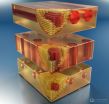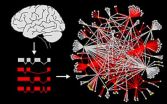(Press-News.org) Researchers at Ludwig-Maximilians-Universitaet (LMU) in Munich have shown how nerve cells flexibly adapt to acoustic signals: Depending on the input signal, neurons generate action potentials either near or far away from the cell body. This flexibility improves our ability to localize sound sources.
In order to process acoustic information with high temporal fidelity, nerve cells may flexibly adapt their mode of operation according to the situation. At low input frequencies, they generate most outgoing action potentials close to the cell body. Following inhibitory or high frequency excitatory signals, the cells produce many action potentials more distantly. This way, they are highly sensitive to the different types of input signals. These findings have been obtained by a research team headed by Professor Christian Leibold, Professor Benedikt Grothe, and Dr. Felix Felmy from Ludwig-Maximilians-Universitaet (LMU) in Munich and the Bernstein Center and the Bernstein Focus Neurotechnology in Munich, who used computer models in their study. The researchers report their results in the latest issue of The Journal of Neuroscience.
Did the bang come from ahead or from the right? In order to localize sound sources, nerve cells in the brain stem evaluate the different arrival times of acoustic signals at the two ears. Being able to detect temporal discrepancies of up to 10 millionths of a second, the neurons have to become excited very quickly. In this process, they change the electrical voltage that prevails on their cell membrane. If a certain threshold is exceeded, the neurons generate a strong electrical signal — a so-called action potential — which can be transmitted efficiently over long axon distances without weakening. In order to reach the threshold, the input signals are summed up. This is achieved easier, the slower the nerve cells alter their electrical membrane potential.
Input signals are optimally processed
These requirements — rapid voltage changes for a high temporal resolution of the input signals, and slow voltage changes for an optimal signal integration that is necessary for the generation of an action potential — represent a paradoxical challenge for the nerve cell. "This problem is solved by nature by spatially separating the two processes. While input signals are processed in the cell body and the dendrites, action potentials are generated in the axon, a cell process," says Leibold, leader of the study. But how sustainable is the spatial separation?
In their study, the researchers measured the axons' geometry and the threshold of the corresponding cells and then constructed a computer model that allowed them to investigate the effectiveness of this spatial separation. The researchers' model predicts that depending on the situation, neurons produce action potentials with more or less proximity to the cell body. For high frequency or inhibitory input signals, the cells will shift the location from the axon's starting point to more distant regions. In this way, the nerve cells ensure that the various kinds of input signals are optimally processed — and thus allow us to perceive both small and large acoustic arrival time differences well, and thereby localize sounds in space.
INFORMATION: END
How nerve cells flexibly adapt to acoustic signals
2014-04-11
ELSE PRESS RELEASES FROM THIS DATE:
Study resolves controversy over nitrogen's ocean 'exit strategies'
2014-04-11
A decades-long debate over how nitrogen is removed from the ocean may now be settled by new findings from researchers at Princeton University and their collaborators at the University of Washington.
The debate centers on how nitrogen — one of the most important food sources for ocean life and a controller of atmospheric carbon dioxide — becomes converted to a form that can exit the ocean and return to the atmosphere where it is reused in the global nitrogen cycle.
Researchers have argued over which of two nitrogen-removal mechanisms, denitrification and anammox, is ...
Forging iron women
2014-04-11
Published in the Journal of Nutrition, researchers undertook a systematic review and analysis of the effect of iron supplementation to the exercise performance of women aged from .
Lead researcher, Dr Sant-Rayn Pasricha from the Melbourne School of Population and Global Health found that iron supplementation improved women's exercise performance, in terms of both the highest level they could achieve at 100% exertion (maximal capacity) and their exercise efficiency at a submaximal exertion. Women who were given iron were able to perform a given exercise using a lower ...
Eye of the beholder -- improving the human-robot connection
2014-04-11
Researchers are programming robots to communicate with people using human-like body language and cues, an important step toward bringing robots into homes.
Researchers at the University of British Columbia enlisted the help of a human-friendly robot named Charlie to study the simple task of handing an object to a person. Past research has shown that people have difficulty figuring out when to reach out and take an object from a robot because robots fail to provide appropriate nonverbal cues.
"We hand things to other people multiple times a day and we do it seamlessly," ...
Greenland ice cores show industrial record of acid rain, success of US Clean Air Act
2014-04-11
The rise and fall of acid rain is a global experiment whose results are preserved in the geologic record.
By analyzing samples from the Greenland ice sheet, University of Washington atmospheric scientists found clear evidence of the U.S. Clean Air Act. They also discovered a link between air acidity and how nitrogen is preserved in layers of snow, according to a paper published this week in the Proceedings of the National Academy of Sciences.
Forty-five years ago, acid rain was killing fish and dissolving stone monuments on the East Coast. Air pollution rose beginning ...
Researchers develop ErSb nanostructures with applications in infrared and terahertz ranges
2014-04-11
In a feat that may provide a promising array of applications, from energy efficiency to telecommunications to enhanced imaging, researchers at UC Santa Barbara have created a compound semiconductor of nearly perfect quality with embedded nanostructures containing ordered lines of atoms that can manipulate light energy in the mid-infrared range. More efficient solar cells, less risky and higher resolution biological imaging, and the ability to transmit massive amounts of data at higher speeds are only a few applications that this unique semiconductor will be able to support.
"This ...
The taming of the shrew
2014-04-11
The Borna disease – named after the German city of Borna, which saw a cluster of cases over 100 years ago – mainly affects horses and sheep, and in rare cases cattle and rabbits too. A single case of an infected dog has been reported. Affected horses seclude themselves from the herd and suffer from depression and general disorientation. Ultimately, this incurable infection is fatal.
Borna virus detected in bicoloured shrews
Researchers have long been in the dark concerning the transmission mechanism of the Borna virus. The bicoloured shrew was one suspect, but definitive ...
Nobel prize candidates wait often over 20 years to win their prize
2014-04-11
Candidates for a Nobel prize often have to wait more than 20 years to receive this highest of scientific accolades. According to a Correspondence by Santo Fortunato of Aalto University in Finland and colleagues, such nail-biting delays are becoming the norm — to the point that aspiring laureates may themselves have expired by the time the medal is due to be presented.
Before 1940, Nobel prizes were awarded more than 20 years after the original discovery for only about 11%, 15% and 24% of physics, chemistry and physiology or medicine prizes, respectively. But by 1985, ...
The ATM strikes back
2014-04-11
Its head and pronotum are usually rusty red, and its abdomen blue or shiny green: the bombardier beetle is approximately one centimetre long and common to Central Europe. At first glance, it appears harmless, but it possesses what is surely the most aggressive chemical defence system in nature. When threatened, the bombardier beetle releases a caustic spray, accompanied by a popping sound. This spray can kill ants or scare off frogs. The beetle produces the explosive agent itself when needed. Two separately stored chemicals are mixed in a reaction chamber in the beetle's ...
Splice variants reveal connections among autism genes
2014-04-11
A team of researchers from the University of California, San Diego School of Medicine and the Center for Cancer Systems Biology (CCSB) at the Dana-Farber Cancer Institute has uncovered a new aspect of autism, revealing that proteins involved in autism interact with many more partners than previously known. These interactions had not been detected earlier because they involve alternatively spliced forms of autism genes found in the brain.
In their study, published in the April 11, 2014 online issue of Nature Communications, the scientists isolated hundreds of new variants ...
Young athletes from higher income families more likely to suffer serious overuse injuries
2014-04-11
MAYWOOD, Il. (April 11, 2014) – A Loyola University Medical Center study is reporting for the first time a link between overuse injury rates in young athletes and their socioeconomic status.
The rate of serious overuse injuries in athletes who come from families that can afford private insurance is 68 percent higher than the rate in lower-income athletes who are on public insurance (Medicaid), the study found.
The study also found that privately insured young athletes are twice as likely as publicly insured athletes to be highly specialized in one sport. Loyola researchers ...



